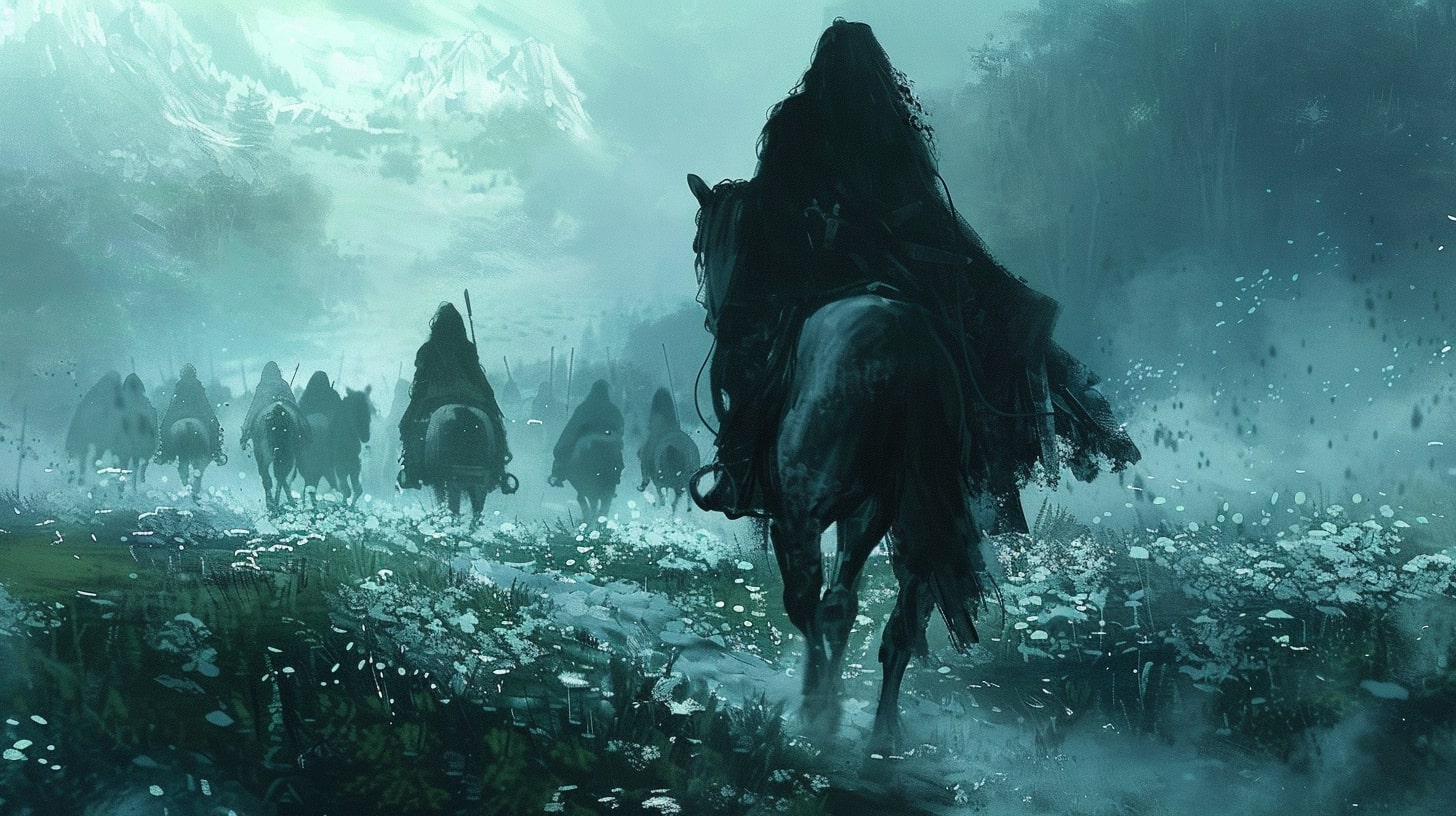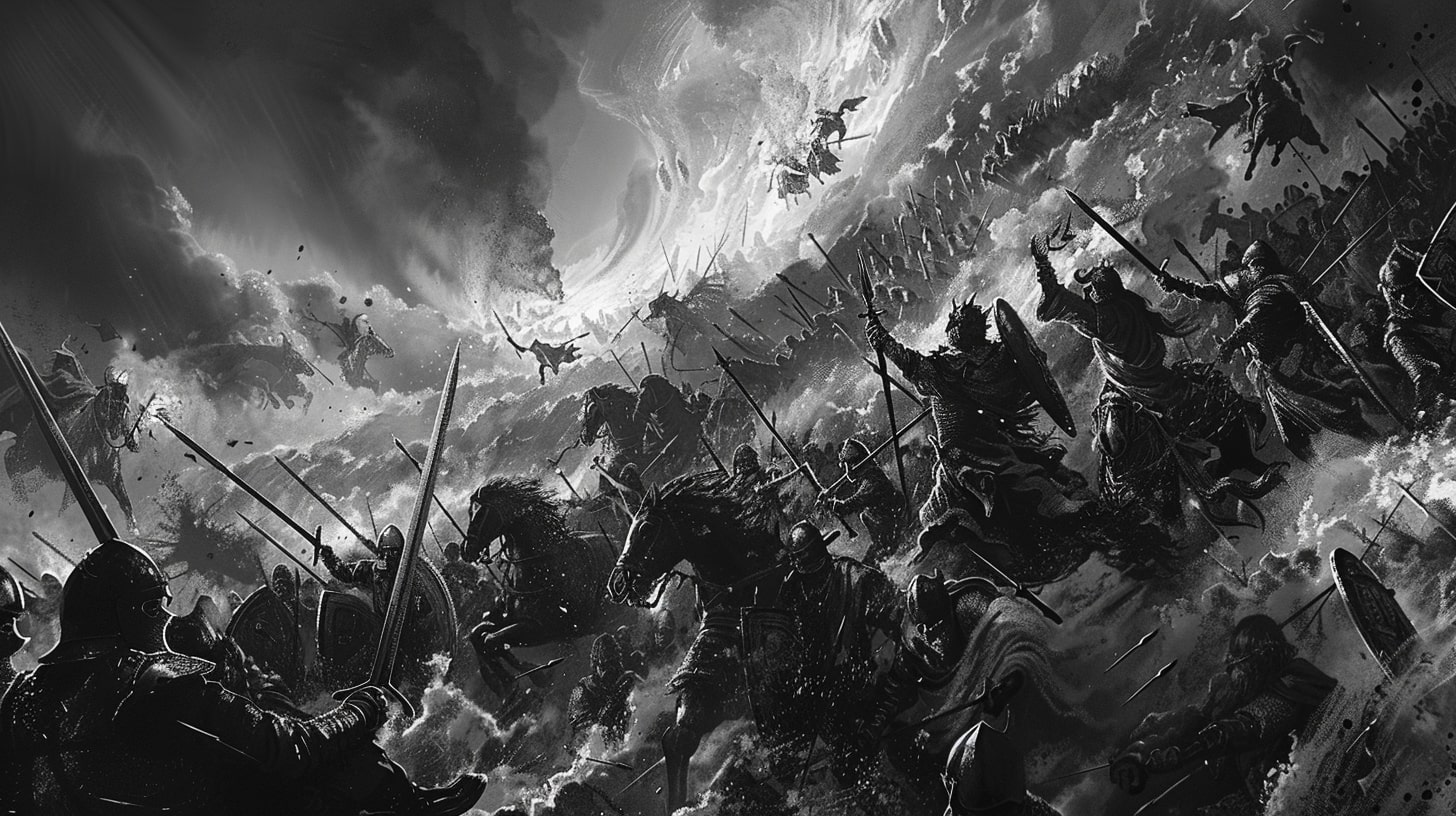Embarking on a Fantasy Quest
Are you ready to embark on an epic journey through the realms of imagination? Writing a fantasy quest is a thrilling endeavor that allows you to create magical worlds, unforgettable characters, and captivating adventures.
I hope to show you the joy that you can have in writing fantasy quests and what you can do to ensure that you write ones that captivate your audience.
The Magic of Fantasy Quests
Fantasy quests have a unique allure that captures the hearts and minds of readers. They transport us to extraordinary realms where ordinary individuals are called upon to undertake extraordinary tasks.
These quests are often filled with danger, mystery, and the promise of personal growth and triumph. As a writer, you have the power to unleash your creativity and weave a narrative that will captivate readers and leave them yearning for more.
Fantasy quests allow us to explore universal themes such as bravery, friendship, sacrifice, and the eternal struggle between good and evil. They ignite our imaginations and take us on a journey of self-discovery. By immersing ourselves in these fantastical worlds, we can experience a sense of wonder and excitement that is unparalleled.
Understanding the Elements of a Quest
To craft a captivating fantasy quest, it’s essential to understand the key elements that define this genre. Let’s take a closer look at these elements:
The Hero: Every quest needs a hero or heroine who embarks on a perilous adventure. This protagonist is often an ordinary individual who is called upon to fulfill a great destiny. They possess unique qualities such as bravery, resilience, and determination, which are tested and shaped throughout their journey.
The Goal: A quest is driven by a clear and compelling goal. This goal may involve the retrieval of a powerful artifact, the rescue of a captive, or the defeat of a menacing villain. The hero’s journey is centered around accomplishing this goal and overcoming numerous obstacles along the way.
Obstacles and Challenges: A quest is never easy. It is filled with obstacles, challenges, and adversaries that the hero must face and overcome. These challenges may be physical, emotional, or psychological in nature, and they serve to test the hero’s mettle and push them to their limits.
Compelling Characters: In addition to the hero, a fantasy quest is brought to life by a diverse cast of characters. These characters may include allies, mentors, wise sages, and formidable adversaries. Each character contributes to the depth and richness of the story, adding layers of complexity and intrigue.
By understanding and harnessing these elements, you can create a fantasy quest that will transport readers to a world of magic and wonder. So, grab your pen and set forth on a grand adventure, for the realms of imagination await your arrival!
Continue your journey into the world of fantasy writing with our article on how to write fantasy novels and explore more fantasy writing tips to enhance your storytelling skills.

Writing Fantasy Quests: Crafting a Captivating Quest
To write a captivating fantasy quest, you need to carefully craft the elements that will draw readers into your story. This section focuses on three key aspects: establishing a clear goal, creating obstacles and challenges, and developing compelling characters.
Establishing a Clear Goal
Every successful quest needs a clear and compelling goal for the protagonist to pursue. This goal acts as the driving force of the story, giving the quest purpose and direction. The goal should be specific and meaningful, offering a strong motivation for the characters to embark on the quest.
Consider the stakes involved in the quest. What will happen if the goal is not achieved? How will the world or characters be affected? By establishing the importance of the goal, you create a sense of urgency and tension that will engage readers and keep them invested in the quest’s outcome.
Creating Obstacles and Challenges
A captivating quest requires a series of obstacles and challenges that the characters must face and overcome. These obstacles can come in various forms, such as physical barriers, puzzles, or conflicts with other characters. They should test the characters’ skills, resourcefulness, and determination.
As you create obstacles, think about how they relate to the goal of the quest. Each obstacle should bring the characters closer to or further from their objective, driving the story forward. These challenges also provide opportunities for character growth and development, allowing readers to connect with the characters on a deeper level.
Developing Compelling Characters
The characters in your quest play a vital role in capturing readers’ attention and keeping them engaged. Develop characters that are relatable, multi-dimensional, and have their own motivations and conflicts. This will make readers care about their journeys and root for their success.
Consider the roles each character will play in the quest. The protagonist should be someone readers can empathize with and cheer for, while the antagonist or obstacles can create tension and conflict. Additionally, supporting characters can provide assistance, guidance, or serve as foils to the protagonist.
By developing compelling characters, you breathe life into your quest and make it more immersive. Readers will become emotionally invested in the characters’ struggles and triumphs, heightening their enjoyment of the story.
Crafting a captivating quest involves establishing a clear goal, creating obstacles and challenges, and developing compelling characters. These elements work together to create a dynamic and engaging narrative. Keep in mind that each quest is unique, and you have the freedom to tailor these elements to suit your story and style of writing. For more tips on writing engaging fantasy quests, check out our article on how to write fantasy novels.

Building Your Fantasy World
To create a captivating fantasy quest, it’s essential to build a rich and immersive fantasy world. This involves setting the stage, cultivating a rich lore and history, and incorporating magical elements that will transport your readers to a realm of wonder and excitement.
Setting the Stage
The setting of your fantasy world serves as the backdrop for your quest. It’s important to establish a vivid and detailed environment that captures the imagination of your readers.
Consider the geography, climate, and architecture of your world. Are there sprawling forests, towering mountains, or mystical floating islands? Describing the setting with rich sensory details will help bring it to life and immerse readers in the experience.
Cultivating a Rich Lore and History
A compelling fantasy world is grounded in a rich lore and history. Develop a backstory for your world that spans centuries or even millennia. Create myths, legends, and historical events that have shaped the current state of the world.
This adds depth and complexity to your storytelling, making the world feel lived-in and realistic. Remember to maintain consistency in your worldbuilding, as readers will appreciate a coherent and well-thought-out lore.
Consider creating a detailed timeline of important events, the rise and fall of civilizations, and the origins of magical beings or artifacts. This will allow you to reference past events and add depth to your quests. Internal links to articles on creating a fantasy world and crafting fantasy prophecies can provide further guidance in this area.
Incorporating Magical Elements
Magic is often a central aspect of fantasy worlds. Whether it’s elemental magic, arcane spells, or mystical creatures, incorporating magical elements into your world can add enchantment and wonder to your quests.
Consider the rules and limitations of magic within your world. Are there specific magical systems or schools of magic? Are certain individuals born with magical abilities, or can anyone learn magic?
Incorporate magical creatures, artifacts, or locations that are unique to your world. These elements can act as catalysts for your quests, providing challenges and opportunities for your characters to overcome.
By designing and describing these magical elements in detail, you can captivate readers and make your world feel truly fantastical.
By setting the stage, cultivating a rich lore and history, and incorporating magical elements, you can create a captivating fantasy world that serves as the foundation for your quests.
Remember to engage the reader’s imagination with vivid descriptions and appealing sensory details. With a well-developed fantasy world, your quests will come alive, transporting readers on an epic adventure they won’t soon forget.

Plotting the Journey
In the realm of fantasy quests, plotting the journey is a crucial step in creating an engaging and immersive narrative. This section will explore the key elements involved in plotting a fantasy quest, including mapping out the quest, structuring the narrative, and maintaining tension and momentum.
Mapping out the Quest
Before delving into the details of your fantasy quest, it’s essential to have a clear map of the journey your characters will undertake. Consider the various locations, environments, and obstacles your characters will encounter along the way. A well-defined map provides a sense of direction and purpose, allowing you to guide your characters through a series of challenges and experiences.
To help you visualize and organize the journey, consider creating a table or diagram to outline the main locations, major events, and significant milestones. This visual representation will serve as a reference point as you build the narrative, ensuring consistency and coherence throughout the quest.
Structuring the Narrative
Structuring the narrative of your fantasy quest is vital for keeping your readers engaged and invested in the story. Consider using a traditional three-act structure or a modified version that suits your quest’s unique needs. The three acts typically include the setup, the confrontation, and the resolution.
During the setup, introduce your main characters, establish their motivations, and provide a glimpse into the world they inhabit. This is where you set the stage for the quest and establish the initial conflict or problem that needs to be solved.
In the confrontation, your characters face a series of obstacles, challenges, and conflicts as they journey towards their goal. Each encounter should build upon the previous one, escalating the tension and raising the stakes. Introduce twists, surprises, and moments of uncertainty to keep your readers on their toes.
The resolution is where the quest reaches its climax and the main conflict is resolved. Ensure that the resolution is satisfying and ties up loose ends, providing a sense of closure for both the characters and the readers.
Maintaining Tension and Momentum
To keep your readers captivated throughout the quest, it’s crucial to maintain tension and momentum in your narrative. Consider pacing the story effectively, alternating between moments of high intensity and quieter, reflective moments. This ebb and flow of tension will create a dynamic reading experience that keeps readers engaged.
As the quest progresses, continually raise the stakes and introduce new challenges for your characters. This will prevent the story from stagnating and maintain a sense of urgency and excitement. Avoid unnecessary detours or lengthy exposition that may slow down the pace of the narrative.
Utilize cliffhangers, unexpected twists, and moments of uncertainty to keep readers eagerly turning the pages. By strategically placing these elements throughout the story, you can create a sense of anticipation and excitement that propels the quest forward.
By mapping out the quest, structuring the narrative, and maintaining tension and momentum, you can craft a captivating and immersive fantasy quest that will transport your readers to a world of adventure and wonder. So grab your pen and embark on a journey of your own creation, where heroes rise, challenges abound, and the fate of the realm hangs in the balance.
Writing Engaging Quest Dialogue
In the realm of fantasy quests, crafting engaging dialogue is essential to bringing your characters and their adventures to life. Well-written dialogue not only develops the personalities of your characters but also advances the plot and adds depth to the quest. Here are some key aspects to consider when writing dialogue for your fantasy quests: capturing character voices, balancing exposition and action, and infusing dialogue with conflict and tension.
Capturing Character Voices
Each character in your quest should have a distinct voice that reflects their personality, background, and motivations. To capture character voices effectively, consider their speech patterns, vocabulary, and tone. A grizzled warrior might speak in short, direct sentences with a rough edge, while a wise old wizard may use a more formal and eloquent style.
By staying consistent with each character’s voice, you not only make them more believable but also create opportunities for memorable interactions and moments of humor or tension. Remember to use internal links to reference other articles, such as creating fantasy characters, for more tips on developing well-rounded and authentic characters.
Balancing Exposition and Action
When writing quest dialogue, it’s important to strike a balance between providing necessary information and keeping the story moving. Too much exposition can slow down the pace and bore readers, while an overabundance of action without context can leave them feeling confused. Aim for a balance that keeps readers engaged without overwhelming them.
Incorporate exposition into the dialogue subtly, allowing information to unfold naturally through character interactions and conversations. This way, your readers can discover important details while feeling immersed in the quest itself. Utilize internal links to direct readers to related articles, such as writing fantasy dialogue, for additional guidance on mastering the art of dialogue in fantasy writing.
Infusing Dialogue with Conflict and Tension
Conflict and tension are critical components of any engaging quest. Dialogue can be a powerful tool for intensifying these elements. Create conflict by incorporating differing opinions, hidden agendas, or unresolved issues among your characters. Tension can arise from the stakes involved, the urgency of the quest, or the presence of external threats.
Through dialogue, characters can reveal their desires, express their fears, and clash with one another. These interactions not only drive the plot forward but also deepen character development and provide opportunities for growth and transformation.
Remember to use dialogue tags and body language to enhance the emotional impact of your characters’ conversations. By showing the subtext beneath their words, you can heighten the conflict and tension, making your readers eager to discover how the quest unfolds.
By focusing on capturing character voices, balancing exposition and action, and infusing dialogue with conflict and tension, you can create engaging and compelling quest dialogue that immerses readers in your fantastical world. With practice and attention to detail, your characters will come alive through their words, making your fantasy quests truly unforgettable.
Evoking Emotion and Immersion
To truly captivate readers and immerse them in your fantastical world, it’s essential to evoke emotion and create a sense of immersion in your writing. By employing techniques such as creating vivid descriptions, appealing to the senses, and engaging the reader’s imagination, you can transport your audience into the heart of your fantasy quest.
Creating Vivid Descriptions
One of the most powerful tools at your disposal is vivid descriptions. By painting a detailed picture with your words, you can bring your fantasy world to life and make it feel tangible to your readers. Use colorful adjectives and strong verbs to describe the characters, settings, and events in your quest. For example:
The towering ancient trees whispered secrets to each other as their gnarled branches reached out like fingers to touch the heavens. The air was thick with the scent of moss and damp earth, while the ground beneath our feet crunched with the fallen leaves of centuries past.
By crafting descriptive passages like this, you can transport your readers directly into the heart of your quest, allowing them to see, hear, and feel the world you’ve created.
Appealing to the Senses
Engaging the senses is another powerful technique for immersing readers in your fantasy quest. By appealing to sight, sound, smell, taste, and touch, you can make your readers feel as though they are experiencing the quest firsthand.
For example, you could describe the taste of a delicious feast in a grand hall, the sound of a sword clashing against a shield in a fierce battle, or the feel of a cool breeze on a mountaintop. By incorporating sensory details throughout your writing, you can make your readers feel as though they are right beside your characters, experiencing the quest alongside them.
Engaging the Reader’s Imagination
Lastly, engaging the reader’s imagination is key to creating a truly immersive experience. Rather than spoon-feeding every detail, leave room for your readers to fill in the gaps with their own imagination. Provide just enough information to set the stage and let your readers’ minds run wild.
For example, instead of describing every minute detail of a fantastical creature, you could provide a few key characteristics and allow your readers to envision the rest. By doing so, you invite your readers to become active participants in the story, making it a more personal and engaging experience.
Remember to use descriptive language, sensory details, and a touch of mystery to engage the reader’s imagination and let their own creativity take flight.
Incorporating these techniques into your writing will help you create a fantasy quest that not only entertains but also immerses your readers in a world of magic and adventure. By creating vivid descriptions, appealing to the senses, and engaging the reader’s imagination, you can unleash your inner hero and craft a truly captivating tale.




































